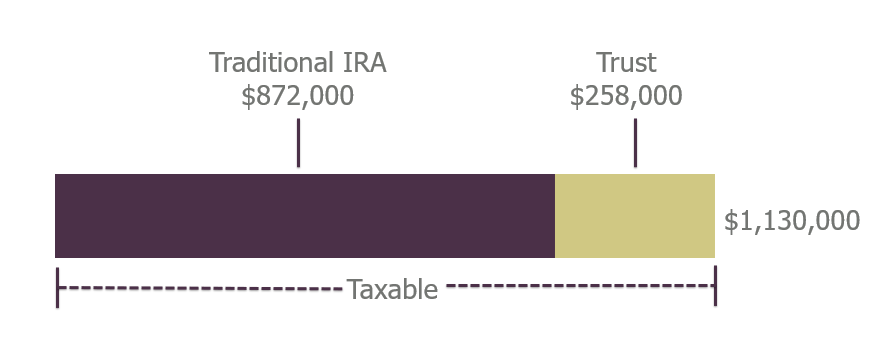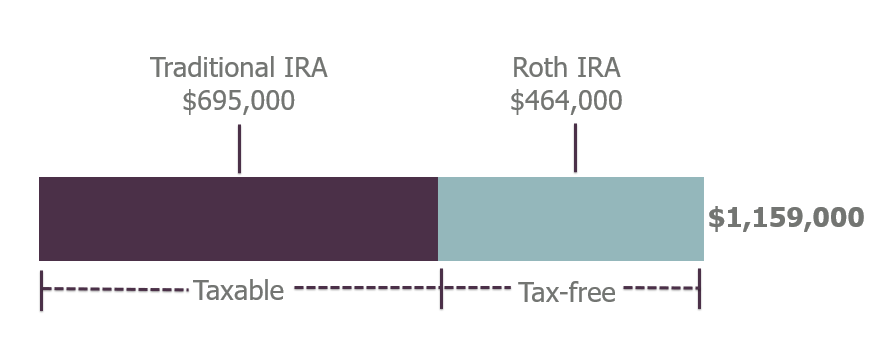Is There a Right Way to Make a Roth Conversion?
Converting some of your traditional IRA funds into a Roth can be a great strategy as you approach retirement. But be careful about how you incorporate such a move into your retirement withdrawal plan.


A commonly recommended strategy for reducing your tax burden and the impact of required minimum distributions (RMDs) is a Roth conversion. You’ll have no trouble finding information on why you should consider converting pretax IRA money to a Roth IRA in a low-income year. Simply put, a Roth IRA lets people at least age 59½ withdraw money tax free and is not subject to RMDs. But, what may be harder to find is a demonstration of how to fully maximize a Roth conversion’s potential benefits.
Keep in mind though, each person’s financial situation is different, meaning a Roth conversion doesn’t make sense for everyone. Since you must pay income taxes on the amount you convert to a Roth, it’s ideal to do it in a low-tax year. Some retirees who live off of a steady annual income throughout retirement may never have a low-tax year. So, a series of Roth conversions would only add to their taxable income and potentially push them into a higher tax bracket.
An example would be traditional IRA owners who have no income other than Social Security. As it’s unlikely Social Security is enough to cover all of one’s retirement expenses, it’s safe to assume you would need to supplement it with a regular withdrawals from your IRA each year. Thus, a Roth conversion would only increase your annual income and, subsequently, your tax burden.
From just $107.88 $24.99 for Kiplinger Personal Finance
Become a smarter, better informed investor. Subscribe from just $107.88 $24.99, plus get up to 4 Special Issues

Sign up for Kiplinger’s Free Newsletters
Profit and prosper with the best of expert advice on investing, taxes, retirement, personal finance and more - straight to your e-mail.
Profit and prosper with the best of expert advice - straight to your e-mail.
Nonetheless, there are many retirees who would be better off making a multiyear Roth conversion.
One couple’s story illustrates the Roth strategy
I find the best way to understand complex subjects such as this is through a story. Therefore, I would like to explore this strategy with a fictitious couple, but with actual dollar amounts. Everyone, meet John and Jane.
John and Jane are a retired, married couple who file their taxes jointly. They both turn 62 this November and will file for Social Security payments in January of next year. Together, they will receive $35,000 per year from Social Security. At the end of this year, they will have $750,000 in a traditional IRA and $250,000 in a trust.
John and Jane
Retirement date: Age 62
Combined Social Security benefit: $35,000/year
Assets:
- Traditional IRA: $750,000
- Trust: $250,000
Working with their financial adviser, John and Jane set a goal to keep the size of their retirement assets approximately the same as they approach age 90. They want to live a comfortable retirement but also leave some money to their children and grandchildren. They determine that given a 2.25% cost-of-living adjustment, they’ll have $70,000 in net income from savings and Social Security throughout their golden years. It’s also assumed that their accounts earn a pretax return of 5.9%. Now, let’s see how different strategies help them realize their goal.
Strategy 1: Drawing down assets proportionately
The first strategy they discuss is to take a proportionate withdrawal from both their IRA and trust money. Starting in January, they would take $28,000 in distributions from their IRA and $12,000 from their trust, which is about a 4% withdrawal rate. Adding in Social Security and subtracting taxes from their cash flow, they will have their annual target net income of $70,000. Throughout retirement, they will gradually increase both their trust and IRA withdrawals, keeping the IRA approximately three times the size of the trust.
At age 70½ though, they must start taking RMDs from their IRA. Because RMDs increase as you grow older, by age 85, their RMDs will be large enough that they can gradually cut back on trust distributions. Since they’ve withdrawn less than they earned, by age 90, they can expect to have $872,000 in their IRA and $258,000 in their trust, for a total of $1,130,000. The trust will still generate taxable income, and the IRA will still have unrealized taxes built in.
John and Jane’s assets by age 90

Strategy 2: Making a multiyear Roth conversion
The second strategy they consider involves a few different steps. From the time they retire at age 62 until age 70, they will live entirely off the trust account, preserving more money in their tax-sheltered IRA. In their first year, they withdraw $37,200 to pay expenses, including a tax bill of less than $1,000 that results from their Roth conversion. They will convert $15,000 per year for eight years from their IRA to a Roth. This keeps their taxable Social Security at or near $0. With the standard deduction, they will owe almost no income tax in their 60s.
Once they’re age 70, they should have approximately $1,030,000 in their IRA, $148,000 in a Roth and nothing left in the trust. When RMDs kick in, they will have to take the required amount plus a bit extra to still net them $70,000 per year, including income from Social Security. But, because they kept their IRA from growing too quickly in their 60s, through age 90, their RMDs remain smaller than what they need to take out to maintain their standard of living. The IRA will begin to shrink as they continue to take increasing distributions, but since the Roth account has been left alone, it will grow. By age 90, they have $1,159,000 in savings, 40% of which is in the Roth — tax free and with no RMDs in their lifetime.
Under this strategy, they end up with an extra $29,000 for retirement. But, the real victory is that $464,000 of their total savings is free and clear in a Roth account.
John and Jane’s assets by age 90

If John and Jane chose to convert their entire IRA to a Roth in their lifetime, they would need to double their annual conversions over those eight years to $30,000. Then continued distributions would eliminate their IRA by age 90, leaving $1,014,000 in the Roth. This is obviously a smaller portfolio than either of the previous scenarios, but the money is entirely tax free. This might benefit them depending on the income tax structure at that time or what’s best for their heirs.
As you consider your own strategy, be mindful that there are many balls to keep in the air. You have to understand the rules governing each account you own — qualified vs. non-qualified — as well as the taxability of your assets. Also, be wary of how your income will affect the amount of your taxable Social Security benefit. A Roth conversion can help keep more of your money working for you throughout retirement. But, this is a complicated calculation that may be best performed with the guidance of a financial adviser.
Profit and prosper with the best of Kiplinger's advice on investing, taxes, retirement, personal finance and much more. Delivered daily. Enter your email in the box and click Sign Me Up.

Sean McDonnell, CFP®, is a financial adviser at Advance Capital Management, an independent registered investment adviser based in Southfield, Mich. He works closely with clients to create and implement customized financial plans, as well as provides a wide range of services, including: investment and 401(k) management, retirement planning and tax strategies.
-
 Being an Executor is a Thankless Job: Do It Well Anyway
Being an Executor is a Thankless Job: Do It Well AnywayYou can be a "good" executor of an estate, even though carrying out someone's final wishes can be challenging.
-
 Question: Are You Planning for a 20- or 30-Year Retirement?
Question: Are You Planning for a 20- or 30-Year Retirement?You probably should be planning for a much longer retirement than you are. To avoid running out of retirement savings, you really need to make a plan.
-
 How to Steer Clear of the Medicare Tax Torpedo
How to Steer Clear of the Medicare Tax TorpedoBetter beware, because if you go even $1 over an important income threshold, your Medicare premiums could rise exponentially due to IRMAA surcharges.
-
 Quick Question: Are You Planning for a 20-Year Retirement or a 30-Year Retirement?
Quick Question: Are You Planning for a 20-Year Retirement or a 30-Year Retirement?You probably should be planning for a much longer retirement than you are. To avoid running out of retirement savings, you really need to make a plan.
-
 Don't Get Caught by the Medicare Tax Torpedo: A Retirement Expert's Tips to Steer Clear
Don't Get Caught by the Medicare Tax Torpedo: A Retirement Expert's Tips to Steer ClearBetter beware, because if you go even $1 over an important income threshold, your Medicare premiums could rise exponentially due to IRMAA surcharges.
-
 I'm an Insurance Pro: Going Without Life Insurance Is Like Driving Without a Seat Belt Because You Don't Plan to Crash
I'm an Insurance Pro: Going Without Life Insurance Is Like Driving Without a Seat Belt Because You Don't Plan to CrashLife insurance is that boring-but-crucial thing you really need to get now so that your family doesn't have to launch a GoFundMe when you're gone.
-
 I'm a Tax Attorney: These Are the Year-End Tax Moves You Can't Afford to Miss
I'm a Tax Attorney: These Are the Year-End Tax Moves You Can't Afford to MissDon't miss out on this prime time to maximize contributions to your retirement accounts, do Roth conversions and capture investment gains.
-
 I'm an Investment Adviser: This Is the Tax Diversification Strategy You Need for Your Retirement Income
I'm an Investment Adviser: This Is the Tax Diversification Strategy You Need for Your Retirement IncomeSpreading savings across three "tax buckets" — pretax, Roth and taxable — can help give retirees the flexibility to control when and how much taxes they pay.
-
 Could an Annuity Be Your Retirement Safety Net? 4 Key Considerations
Could an Annuity Be Your Retirement Safety Net? 4 Key ConsiderationsMore people are considering annuities to achieve tax-deferred growth and guaranteed income, but deciding if they are right for you depends on these key factors.
-
 I'm a Financial Pro: Older Taxpayers Really Won't Want to Miss Out on This Hefty (Temporary) Tax Break
I'm a Financial Pro: Older Taxpayers Really Won't Want to Miss Out on This Hefty (Temporary) Tax BreakIf you're age 65 or older, you can claim a "bonus" tax deduction of up to $6,000 through 2028 that can be stacked on top of other deductions.
-
 Meet the World's Unluckiest — Not to Mention Entitled — Porch Pirate
Meet the World's Unluckiest — Not to Mention Entitled — Porch PirateThis teen swiped a booby-trapped package that showered him with glitter, and then he hurt his wrist while fleeing. This is why no lawyer will represent him.